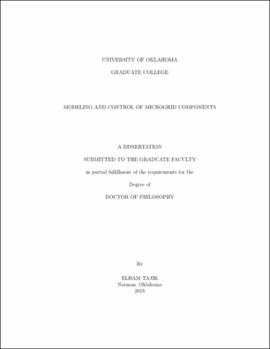| dc.contributor.advisor | Runolfsson, Thordur | |
| dc.contributor.author | Tajik, Elham | |
| dc.date.accessioned | 2018-12-13T21:37:58Z | |
| dc.date.available | 2018-12-13T21:37:58Z | |
| dc.date.issued | 2018-12-14 | |
| dc.identifier.uri | https://hdl.handle.net/11244/316764 | |
| dc.description.abstract | Due to the increase in the integration of renewable energy resources into electrical power systems, there are various challenges that modern power systems are facing.
A lot of issues in this subject are discussed under the concept of microgrid and their operational and control concerns.
Power electronic interfaces (converters, inverters) are necessary for connecting generation units based on renewable energy resources to the power grid. Consequently, inverter control is a primary issue in operating microgrids. Fast dynamics of power electronic interfaces results in different operating concerns and strategies for inverter-based generation units as compared to large conventional synchronous generators. To provide simplicity in operating inverter-based generation units, there are various control strategies based on emulating the critical properties of a conventional synchronous generator such as inertia and damping. This dissertation designs a novel operational and control model for controlled power electronic loads and inverter-based generators inspired by synchronous generators' equations and stated in port-Hamiltonian systems' formulation. This inverter generator controller is added to the inverter switching controller to enable the generator to behave in a manner similar to a synchronous generator.
We develop a control methodology based on Interconnection and Damping Assignment Passivity Based Control (IDA-PBC) strategy for the proposed inverter-based generator dynamics. We prove the stability of the designed closed loop system and develop a simulation model for the projected control strategy that includes an example system consisting of a constant impedance load, a $\pi-$modeled line and an inverter-based generator.
We also develop a generic port-Hamiltonian model for loads that allows through the appropriate selection of structure and controls the mimicking of the behavior of complex loads that are connected to the grid through controlled power electronic interfaces. | en_US |
| dc.language | en_US | en_US |
| dc.subject | Power Systems | en_US |
| dc.subject | Microgrid | en_US |
| dc.subject | Port-Hamiltonian systems | en_US |
| dc.subject | Constant Power Loads | en_US |
| dc.subject | Virtual Machine | en_US |
| dc.subject | Engineering, Electronics and Electrical. | en_US |
| dc.title | MODELING AND CONTROL OF MICROGRID COMPONENTS | en_US |
| dc.contributor.committeeMember | Petrov, Nikola | |
| dc.contributor.committeeMember | Tang, Choon Yik | |
| dc.contributor.committeeMember | Jiang, John | |
| dc.contributor.committeeMember | Moses, Paul | |
| dc.date.manuscript | 2018-12-10 | |
| dc.thesis.degree | Ph.D. | en_US |
| ou.group | Gallogly College of Engineering::School of Electrical and Computer Engineering | en_US |
| shareok.orcid | 0000-0003-0871-8204 | en_US |
| shareok.nativefileaccess | restricted | en_US |
